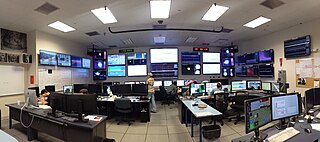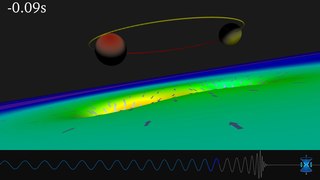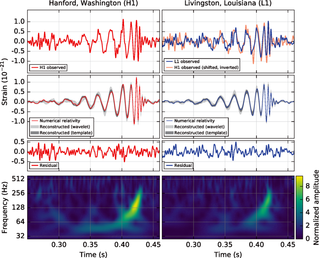Related Research Articles

General relativity, also known as the general theory of relativity and Einstein's theory of gravity, is the geometric theory of gravitation published by Albert Einstein in 1915 and is the current description of gravitation in modern physics. General relativity generalizes special relativity and refines Newton's law of universal gravitation, providing a unified description of gravity as a geometric property of space and time or four-dimensional spacetime. In particular, the curvature of spacetime is directly related to the energy and momentum of whatever matter and radiation are present. The relation is specified by the Einstein field equations, a system of second order partial differential equations.
The following is a timeline of gravitational physics and general relativity.

The Laser Interferometer Gravitational-Wave Observatory (LIGO) is a large-scale physics experiment and observatory designed to detect cosmic gravitational waves and to develop gravitational-wave observations as an astronomical tool. Two large observatories were built in the United States with the aim of detecting gravitational waves by laser interferometry. These observatories use mirrors spaced four kilometers apart to measure changes in length—over an effective span of 1120 km—of less than one ten-thousandth the charge diameter of a proton.

Kip Stephen Thorne is an American theoretical physicist and writer known for his contributions in gravitational physics and astrophysics. Along with Rainer Weiss and Barry C. Barish, he was awarded the 2017 Nobel Prize in Physics for his contributions to the LIGO detector and the observation of gravitational waves.

The Laser Interferometer Space Antenna (LISA) is a planned space probe to detect and accurately measure gravitational waves—tiny ripples in the fabric of spacetime—from astronomical sources. LISA will be the first dedicated space-based gravitational-wave observatory. It aims to measure gravitational waves directly by using laser interferometry. The LISA concept features three spacecraft arranged in an equilateral triangle with each side 2.5 million kilometers long, flying in an Earth-like orbit heliocentric orbit. The distance between the satellites is precisely monitored to detect a passing gravitational wave.
Tests of general relativity serve to establish observational evidence for the theory of general relativity. The first three tests, proposed by Albert Einstein in 1915, concerned the "anomalous" precession of the perihelion of Mercury, the bending of light in gravitational fields, and the gravitational redshift. The precession of Mercury was already known; experiments showing light bending in accordance with the predictions of general relativity were performed in 1919, with increasingly precise measurements made in subsequent tests; and scientists claimed to have measured the gravitational redshift in 1925, although measurements sensitive enough to actually confirm the theory were not made until 1954. A more accurate program starting in 1959 tested general relativity in the weak gravitational field limit, severely limiting possible deviations from the theory.

GEO600 is a gravitational wave detector located near Sarstedt, a town 20 km to the south of Hanover, Germany. It is designed and operated by scientists from the Max Planck Institute for Gravitational Physics, Max Planck Institute of Quantum Optics and the Leibniz Universität Hannover, along with University of Glasgow, University of Birmingham and Cardiff University in the United Kingdom, and is funded by the Max Planck Society and the Science and Technology Facilities Council (STFC). GEO600 is capable of detecting gravitational waves in the frequency range 50 Hz to 1.5 kHz, and is part of a worldwide network of gravitational wave detectors. This instrument, and its sister interferometric detectors, when operational, are some of the most sensitive gravitational wave detectors ever designed. They are designed to detect relative changes in distance of the order of 10−21, about the size of a single atom compared to the distance from the Sun to the Earth. Construction on the project began in 1995.

Ronald William Prest Drever was a Scottish experimental physicist. He was a professor emeritus at the California Institute of Technology, co-founded the LIGO project, and was a co-inventor of the Pound–Drever–Hall technique for laser stabilisation, as well as the Hughes–Drever experiment. This work was instrumental in the first detection of gravitational waves in September 2015.

Gravitational waves are waves of the intensity of gravity that are generated by the accelerated masses of binary stars and other motions of gravitating masses, and propagate as waves outward from their source at the speed of light. They were first proposed by Oliver Heaviside in 1893 and then later by Henri Poincaré in 1905 as the gravitational equivalent of electromagnetic waves. Gravitational waves are sometimes called gravity waves, but gravity waves typically refer to displacement waves in fluids. In 1916 Albert Einstein demonstrated that gravitational waves result from his general theory of relativity as ripples in spacetime.

A gravitational-wave detector is any device designed to measure tiny distortions of spacetime called gravitational waves. Since the 1960s, various kinds of gravitational-wave detectors have been built and constantly improved. The present-day generation of laser interferometers has reached the necessary sensitivity to detect gravitational waves from astronomical sources, thus forming the primary tool of gravitational-wave astronomy.

Gravitational-wave astronomy is a subfield of astronomy concerned with the detection and study of gravitational waves emitted by astrophysical sources.

In cosmology, primordial black holes (PBHs) are hypothetical black holes that formed soon after the Big Bang. In the inflationary era and early radiation-dominated universe, extremely dense pockets of subatomic matter may have been tightly packed to the point of gravitational collapse, creating primordial black holes without the supernova compression typically needed to make black holes today. Because the creation of primordial black holes would pre-date the first stars, they are not limited to the narrow mass range of stellar black holes.

A black hole cosmology is a cosmological model in which the observable universe is the interior of a black hole. Such models were originally proposed by theoretical physicist Raj Kumar Pathria, and concurrently by mathematician I. J. Good.

In astrophysics, an extreme mass ratio inspiral (EMRI) is the orbit of a relatively light object around a much heavier object, that gradually spirals in due to the emission of gravitational waves. Such systems are likely to be found in the centers of galaxies, where stellar mass compact objects, such as stellar black holes and neutron stars, may be found orbiting a supermassive black hole. In the case of a black hole in orbit around another black hole this is an extreme mass ratio binary black hole. The term EMRI is sometimes used as a shorthand to denote the emitted gravitational waveform as well as the orbit itself.
The TianQin Project is a proposed space-borne gravitational-wave observatory consisting of three spacecraft in Earth orbit. The TianQin project is being led by Professor Luo Jun, President of Sun Yat-sen University, and is based in the university's Zhuhai campus. Construction on project-related infrastructure, which will include a research building, ultra-quiet cave laboratory, and observation center, began in March 2016. The project is estimated to cost 15 billion RMB, with a projected completion date in the mid-2030s. In December 2019, China launched Tianqin-1, a technology demonstration.

The first direct observation of gravitational waves was made on 14 September 2015 and was announced by the LIGO and Virgo collaborations on 11 February 2016. Previously, gravitational waves had been inferred only indirectly, via their effect on the timing of pulsars in binary star systems. The waveform, detected by both LIGO observatories, matched the predictions of general relativity for a gravitational wave emanating from the inward spiral and merger of a pair of black holes of around 36 and 29 solar masses and the subsequent "ringdown" of the single resulting black hole. The signal was named GW150914. It was also the first observation of a binary black hole merger, demonstrating both the existence of binary stellar-mass black hole systems and the fact that such mergers could occur within the current age of the universe.

GW 170817 was a gravitational wave (GW) signal observed by the LIGO and Virgo detectors on 17 August 2017, originating from the shell elliptical galaxy NGC 4993. The signal was produced by the last moments of the inspiral process of a binary pair of neutron stars, ending with their merger. It was the first GW observation to be confirmed by non-gravitational means. Unlike the five previous GW detections—which were of merging black holes and thus not expected to produce a detectable electromagnetic signal—the aftermath of this merger was seen across the electromagnetic spectrum by 70 observatories on 7 continents and in space, marking a significant breakthrough for multi-messenger astronomy. The discovery and subsequent observations of GW 170817 were given the Breakthrough of the Year award for 2017 by the journal Science.
Jens Horst Gundlach is a German physicist.

Rana X. Adhikari is an American experimental physicist. He is a professor of physics at the California Institute of Technology (Caltech) and an associate faculty member of the International Centre for Theoretical Sciences of Tata Institute of Fundamental Research (ICTS-TIFR).
Lisa Barsotti is a research scientist at the Massachusetts Institute of Technology Kavli Institute.
References
- ↑ Zhang, Yuan-Zhong; Cai, Rong-Gen; Guo, Zong-Kuan; Ruan, Wen-Hong (2018-07-25). "Taiji Program: Gravitational-Wave Sources". arXiv: 1807.09495v2 [gr-qc].
- ↑ China plans gravitational wave project by CHENG YINGQI, in "China Daily" (2016)
- ↑ Chinese gravitational-wave hunt hits crunch time - The pressure is on to choose between several proposals for space-based detectors. by David Cyranoski in "Nature" 531, 150–151 doi:10.1038/531150a (2016)
- ↑ China Proposes Gravitational Wave Research Projects in "TECH & MILITARY BREAKING NEWS" (2016)
- ↑ China plans project on gravitational wave Archived March 11, 2016, at the Wayback Machine by Cheng Yingqi, in "China Watch" (2016)
- ↑ "China unveils plans for two new gravitational-wave missions". Physics World. 2018-07-11. Retrieved 2019-09-20.
- ↑ Wu, Yue-Liang; Hu, Wen-Rui (2017-09-01). "The Taiji Program in Space for gravitational wave physics and the nature of gravity". National Science Review. 4 (5): 685–686. doi: 10.1093/nsr/nwx116 . ISSN 2095-5138.
- ↑ 高; 刘; 罗; 靳 (2019). "太极计划激光指向调控方案介绍". 中国光学. 12 (3): 7. doi:10.3788/CO.20191203.0425. S2CID 208090926.
- ↑ Yungui Gong, Jun Luo & Bin Wang (15 September 2021). "Concepts and status of Chinese space gravitational wave detection projects". Nature Astronomy. 5 (9): 881–889. arXiv: 2109.07442 . Bibcode:2021NatAs...5..881G. doi:10.1038/s41550-021-01480-3. S2CID 237513499 . Retrieved 2022-03-15.
- ↑ The Taiji Scientific Collaboration (24 February 2021). "China's first step towards probing the expanding universe and the nature of gravity using a space borne gravitational wave antenna". Communications Physics. 4 (1): 34. Bibcode:2021CmPhy...4...34T. doi: 10.1038/s42005-021-00529-z . S2CID 257115954.
- ↑ Ju Chen (陈举)1,2, Chang-Shuo Yan (闫昌硕)1,2, You-Jun Lu (陆由俊)1,2, Yue-Tong Zhao (赵悦同)1,2 and Jun-Qiang Ge (葛均强)1 (December 2021). "On detecting stellar binary black holes via the LISA-Taiji network". Research in Astronomy and Astrophysics. 21 (11): 285. arXiv: 2201.12516 . Bibcode:2021RAA....21..285C. doi:10.1088/1674-4527/21/11/285. S2CID 245574764 . Retrieved 2022-03-15.
{{cite journal}}: CS1 maint: multiple names: authors list (link) CS1 maint: numeric names: authors list (link) - ↑ Wen-Hong Ruan, Zong-Kuan Guo, Rong-Gen Cai and Yuan-Zhong Zhang (June 20, 2020). "Taiji program: Gravitational-wave sources". International Journal of Modern Physics A. 35 (17). arXiv: 1807.09495 . Bibcode:2020IJMPA..3550075R. doi:10.1142/S0217751X2050075X. S2CID 119488616 . Retrieved 2022-03-15.
{{cite journal}}: CS1 maint: multiple names: authors list (link) - ↑ Vitor Cardoso & Paolo Pani (5 September 2017). "Tests for the existence of black holes through gravitational wave echoes". Nature Astronomy. 1 (9): 586–591. arXiv: 1707.03021 . Bibcode:2017NatAs...1..586C. doi:10.1038/s41550-017-0225-y. S2CID 256726079 . Retrieved 2022-03-15.
- ↑ "【科技日报】太极计划:去太空捕捉时空涟漪". China Academy of Science.
- ↑ Yichen Tian (November 1, 2021). "Research on the analytical development and progress of gravitational wave detection technology". Journal of Physics: Conference Series. 2083 (2): 022043. Bibcode:2021JPhCS2083b2043T. doi: 10.1088/1742-6596/2083/2/022043 . S2CID 244838691.
- ↑ Wen-Hong Ruan, Chang Liu, Zong-Kuan Guo, Yue-Liang Wu & Rong-Gen Cai (3 February 2020). "The LISA–Taiji network". Nature Astronomy. 4 (2): 108–109. arXiv: 2002.03603 . Bibcode:2020NatAs...4..108R. doi:10.1038/s41550-019-1008-4. S2CID 256713218 . Retrieved 2022-03-15.
{{cite journal}}: CS1 maint: multiple names: authors list (link) - ↑ 科技日报 (September 24, 2019). ""太极一号":我国空间引力波探测迈出第一步". China National Space Administration. Retrieved 2022-03-15.
- ↑ Xinhua News (October 29, 2019). "China plans more space science satellites". The State Council The People Republic's of China. Retrieved 2022-03-15.
- ↑ Wu, Yue-Liang; Luo, Zi-Ren; Wang, Jian-Yu; Bai, Meng; Bian, Wei; Cai, Rong-Gen; Cai, Zhi-Ming; Cao, Jin; Chen, Di-Jun; Chen, Ling; Chen, Li-Sheng (2021-02-24). "China's first step towards probing the expanding universe and the nature of gravity using a space borne gravitational wave antenna". Communications Physics. 4 (1): 34. Bibcode:2021CmPhy...4...34T. doi: 10.1038/s42005-021-00529-z . ISSN 2399-3650. S2CID 232042193.
- ↑ The Taiji Scientific Collaboration (April 3, 2021). "The pilot of Taiji program — From the ground to Taiji-2". International Journal of Modern Physics A. 36 (11n12). Bibcode:2021IJMPA..3602001T. doi:10.1142/S0217751X21020012. S2CID 240970299 . Retrieved 2022-03-15.
- ↑ Ziren Luo, Yan Wang, Yueliang Wu, Wenrui Hu, Gang Jin (5 May 2021). "The Taiji program: A concise overview". Progress of Theoretical and Experimental Physics. 05A108 (5). doi: 10.1093/ptep/ptaa083 .
{{cite journal}}: CS1 maint: multiple names: authors list (link) - ↑ "Taiji-1 Satellite Released the Scientific Achievements of the First Stage". ICTP-AP. Retrieved 2022-03-15.
- ↑ "【中国新闻网】引力波宇宙太极实验室落户杭州 为太极计划提供技术支撑----中国科学院". www.cas.cn. Retrieved 2022-03-15.